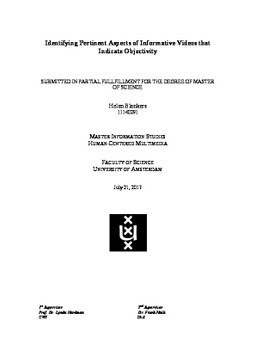2017-07-21
Is Seeing Believing? Identifying Aspects of Informative Videos that Indicate Objectivity
Publication
Publication
Information in online videos can be misleading and unreliable. Video users tend to select videos with misleading information (Butler, 2013). To facilitate video users in their selection of videos they need an objectivity measure (Palumbo, 2012). We propose thirteen aspects of video that contribute to the measure of its objectivity. We ranked the aspects according to their contribution to the objectivity measurement. Spoken content, vocabulary use, title, knowledge of the actor on the subject and facial expressions are the five most prominent contributors. The measurement of objectivity in videos was explored across the three persuasion dimensions: 1) ethos, 2) pathos, 3) logos. Expert opinions on which aspects can be used for video objectivity measurement were solicited. A user survey was carried out to assess the degree to which these aspects contribute to measuring the objectivity.
| Additional Metadata | |
|---|---|
| , , , , , , , | |
| L. Hardman (Lynda) , F.-M. Nack (Frank) | |
| Universiteit van Amsterdam | |
| Organisation | Human-Centered Data Analytics |
|
Boots-Blankers, H. (2017, July 21). Is Seeing Believing? Identifying Aspects of Informative Videos that Indicate Objectivity. |
|

